Acer palmatum
Back when I was in high school, there were a fair number of jocks, i.e. sport-playing athletic people. And while the single-sport kids made it pretty far, it was the multi-sport folks who were the greatest athletes.
The ones who played a different sport every season had the most adaptability, cross-conditioning, and all-around physical awesomeness.
Similarly to these athletes, plants that perform well in every season are the most exemplary.

We link to vendors to help you find relevant products. If you buy from one of our links, we may earn a commission.
One such plant is the coral bark Japanese maple, which – in addition to stunning spring, summer, and fall foliage – also looks amazing in winter.
Even when defoliated during dormancy, the coral pink young growth provides all the splendor you could ask for in the off-season.
In this guide, we’ll provide all the information required to grow this wonderful type of Japanese maple yourself.
Here’s a preview of everything I’ll cover:
What You’ll Learn
What Are Coral Bark Japanese Maples?
“Coral bark Japanese maple” is the common name for various cultivars of A. palmatum with this feature.
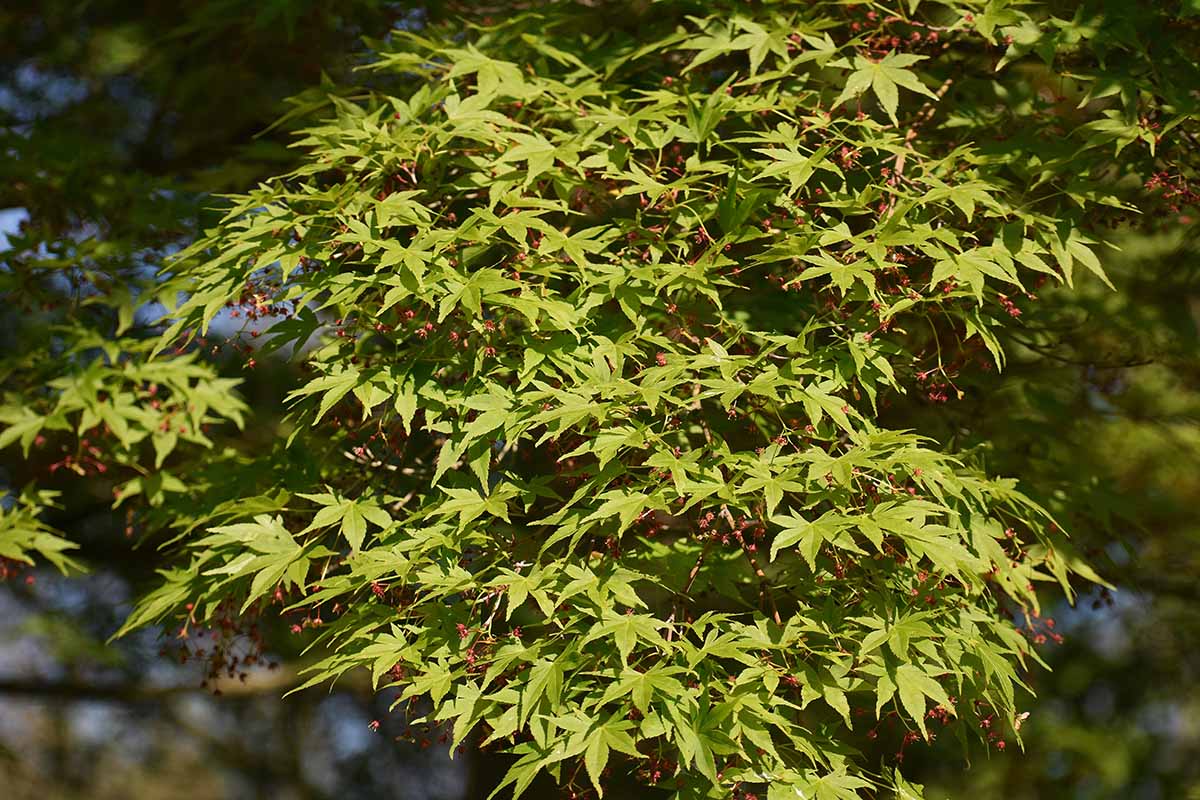
What makes coral barks so special? I’m glad you asked! But here’s a prerequisite primer:
As autumn draws near, the leaves of deciduous trees such as Japanese maples lose chlorophyll in a process known as senescence, which reveals carotenoid, anthocyanin, and xanthophyll pigments within the leaves.
This results in the gorgeous shades of red, yellow, orange, and purple that we see in the fall foliage of deciduous trees.
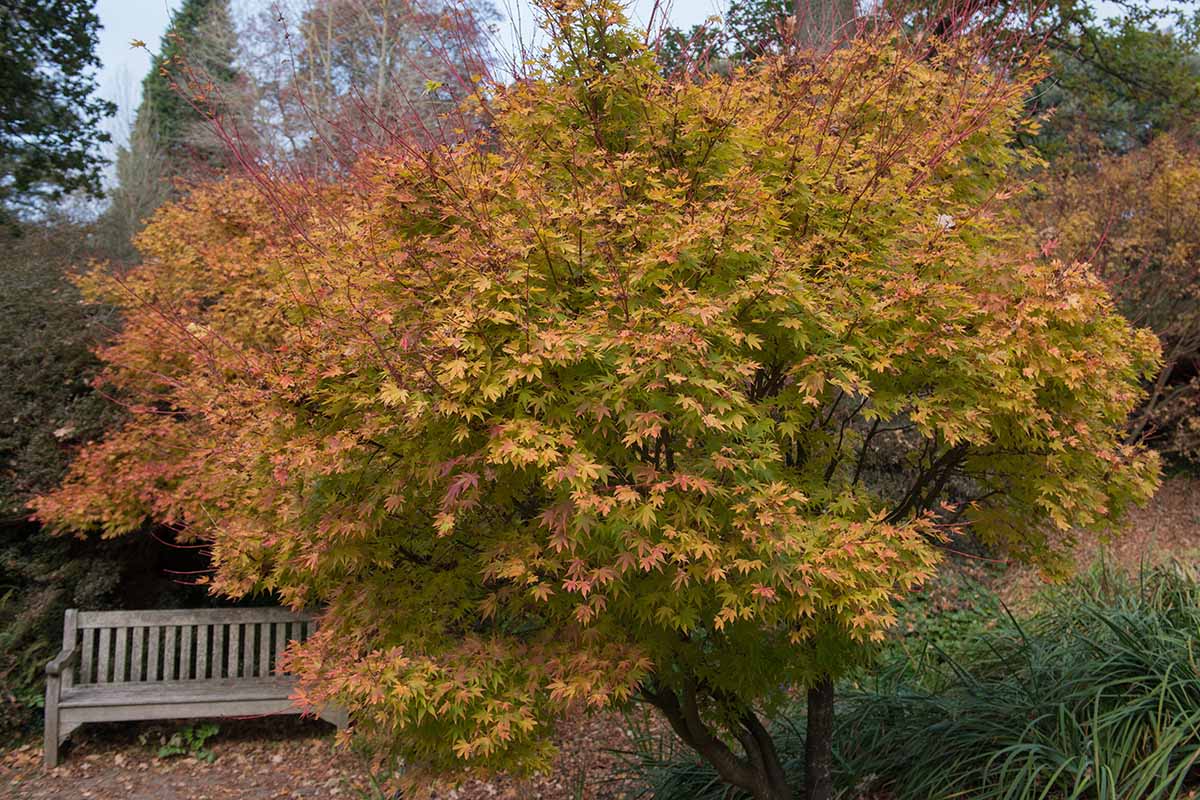
The drawback of this senescence is right there in the name: the gradual deterioration that comes with age. This culminates in the leaves starting to drop, eventually leaving a tree completely defoliated by the time winter rolls around.
And unless the tree has an aesthetic growth habit or bark to look at, then it’ll sort of just… exist in the landscape without contributing much to the scenery.
Thankfully, coral barks have the color and a typically upright branching growth habit to draw the eye, even during the dormant season.
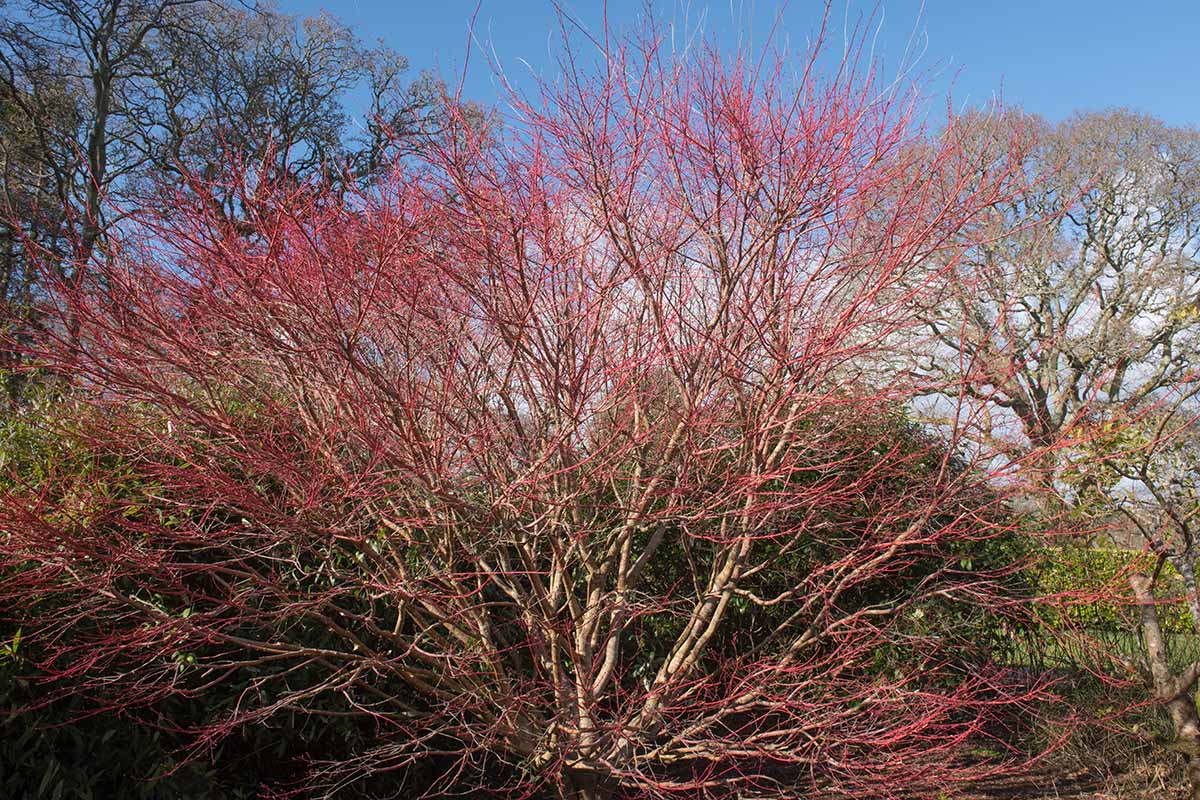
The growing habit of ‘Sango Kaku’ is upright and vase-shaped, for example, while other cultivars with this feature may have a broad or rounded habit.
These forms display the coral colors of the young branches prominently for all to see – it’s the ultimate ornamental alley-oop!
During their first and second years of growth, the branches are a rich coral pink color, which stands out starkly in the dreary winter landscape. The color of the trunk and older branches varies, depending on the cultivar and particular specimen.
Sometimes color fades in a gradient, eventually resulting in a brown to gray hue, while in other specimens the color remains just as prominent as trees age.
Add to that the stunning foliage – light green in spring, changing to a darker shade of green in summer with shades of red, orange, and/or yellow appearing in fall – and you’ve got a plant with year-round visual interest.
This is uncommon for a deciduous tree, which makes a coral bark a fantastic ornamental addition to the garden in all seasons.
Cultivation and History
Like most forms of A. palmatum, coral barks are best grown in USDA Hardiness Zones 5 to 8, and their heritage traces back to a region encompassing China, Japan, and Korea. As a whole, Japanese maples have been cultivated in Japan for centuries.
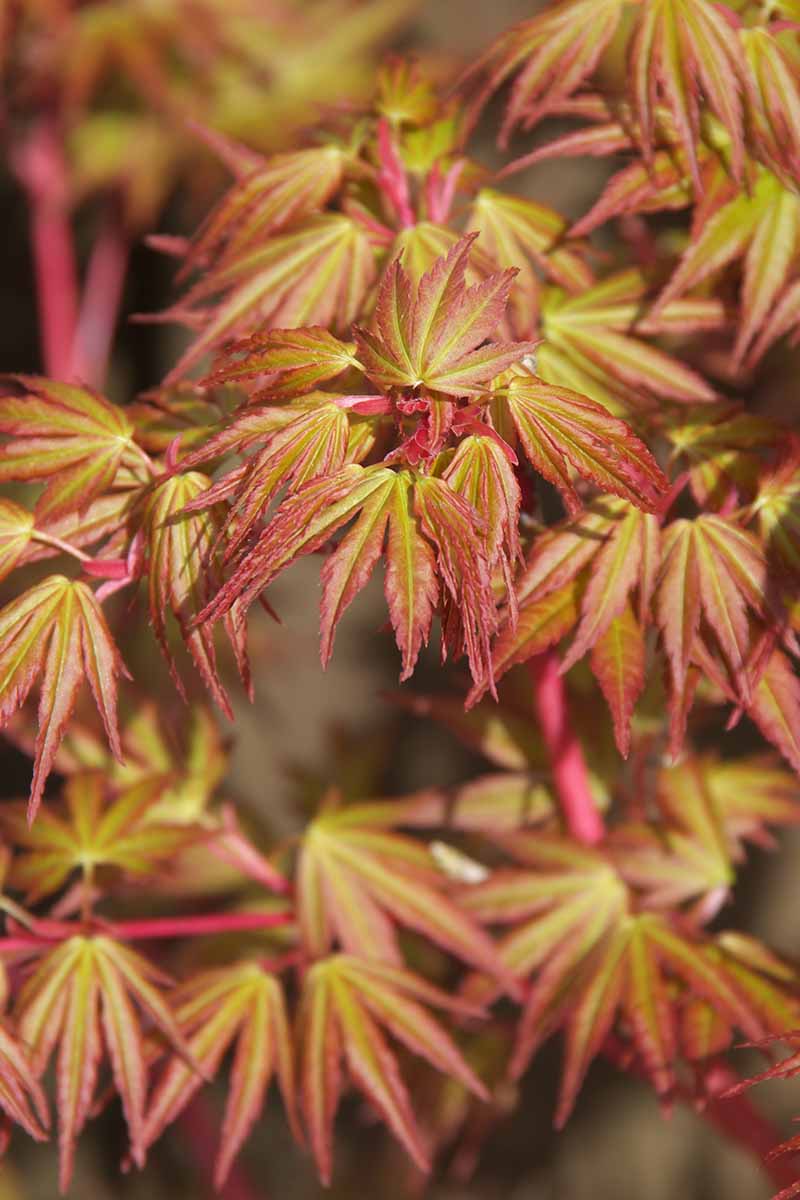
Northern Ireland’s Daisy Hill Nurseries introduced the popular ‘Sankaki’ cultivar for commercial sale in the UK in the 1920s. Some time after, it was renamed ‘Sango-Kaku.’
It was under this moniker that it received the Award of Garden Merit in 1993 from the UK’s Royal Horticultural Society – a prestigious award from a distinguished organization.
In the United States, this cultivar has become a beloved variety. But there are other cultivars to choose from as well, which we’ll cover below in the Cultivars to Select section.
Propagation
It’s best to propagate this variety by rooting cuttings or via transplanting, which we’ll cover here.
I’m hesitant to recommend growing from seed because of any potential genetic variance that could leave you with a less-than-glorious tree that does not share the same qualities as the parent.
These methods will also give you results much more quickly than starting plants from seed.
But if you’d like to give it a try and you’re eager to see what type of results you get, you can learn all about growing Japanese maples from seed in our guide.
From Cuttings
This method is as simple as taking softwood cuttings with a sterilized blade, applying a rooting hormone to the ends of their defoliated lower halves, and rooting them in an appropriate growing medium.
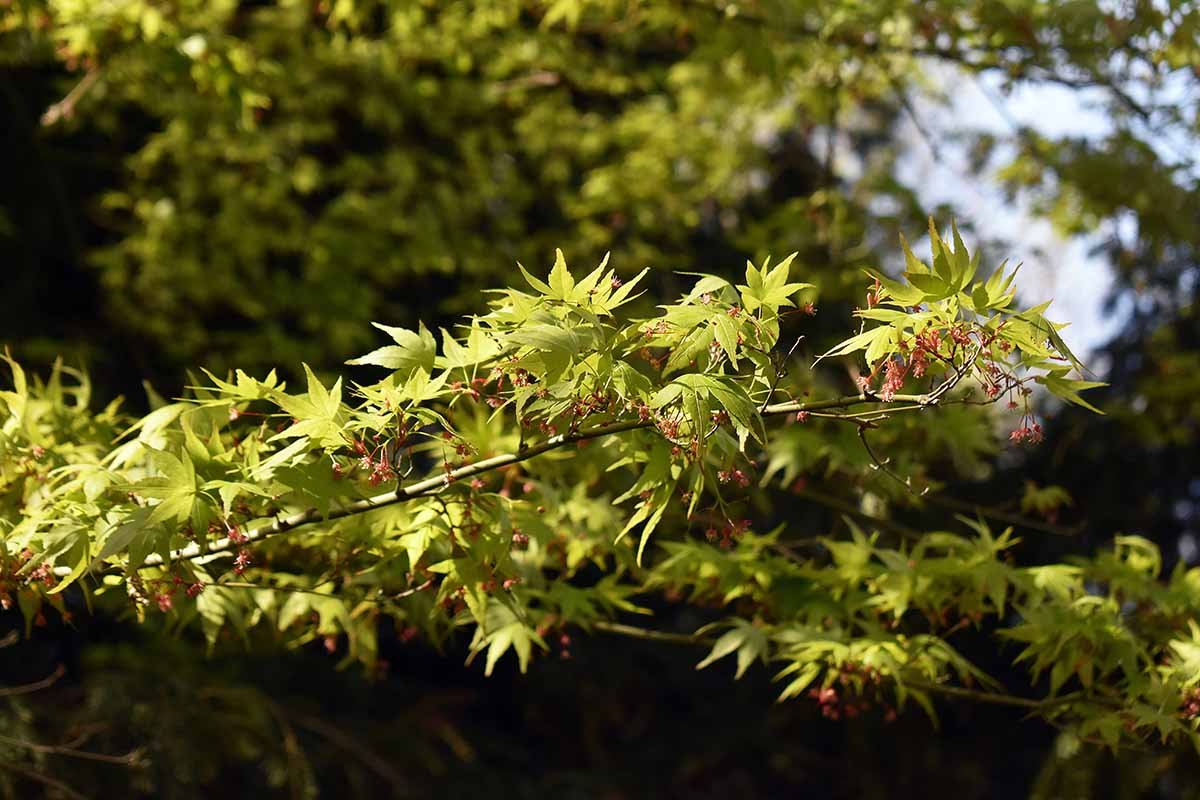
From there, you’ll harden them off outdoors in spring until they’re conditioned to survive outside. At that point they’re ready for transplanting into their permanent location.
For a more in-depth breakdown of the process, you’ll find instructions in the propagation section of our guide to growing Japanese maples.
From Transplants
This is definitely the simpler of the two options. It’s a matter of purchasing a transplant, digging a hole that’s slightly larger than the size of the root system, lowering the plant in, backfilling with the dug-out soil, and then deeply watering it in.
If you select a large transplant to begin with, you may want to recruit some help with planting or consider hiring a professional.
Staking young transplants during the first year or two after planting can help to protect them against harsh winds.
You’ll also want to keep the soil evenly moist for a few years after installation until the transplant becomes established, at which point you can reduce supplemental irrigation.
How to Grow
It would be a shame for the potential of this beautiful tree to go to waste due to improper cultivation. With these pointers, you’ll be able to get it right the first time.
Climate and Exposure Needs
As stated earlier, these trees need to be cultivated in USDA Hardiness Zones 5 to 8 for optimal growth.
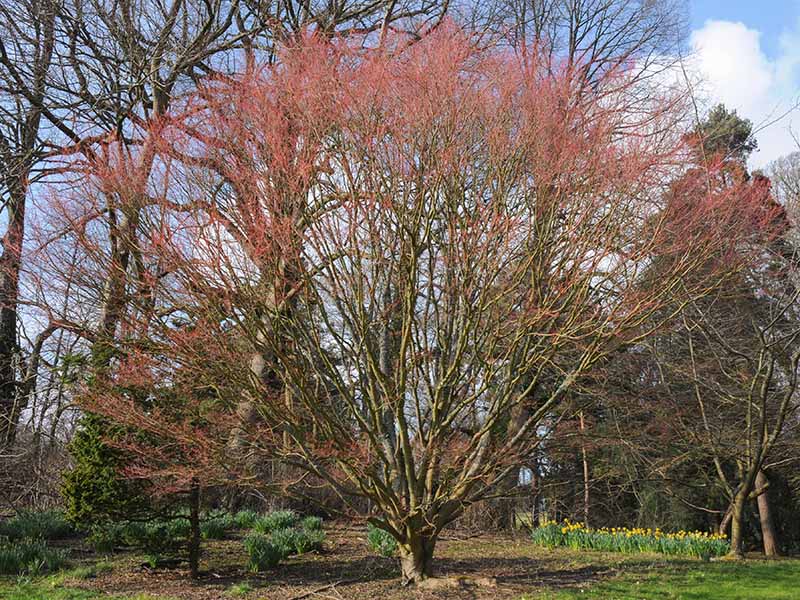
Choose a location protected from strong winds, and be sure to provide a full sun to partial shade exposure.
Soil Needs
Ideal soil for this variety must drain really well. But one of the strengths of the coral bark Japanese maple is its ability to grow in extreme textures such as heavy clay, so don’t be stressed if your soil doesn’t drain like a colander.
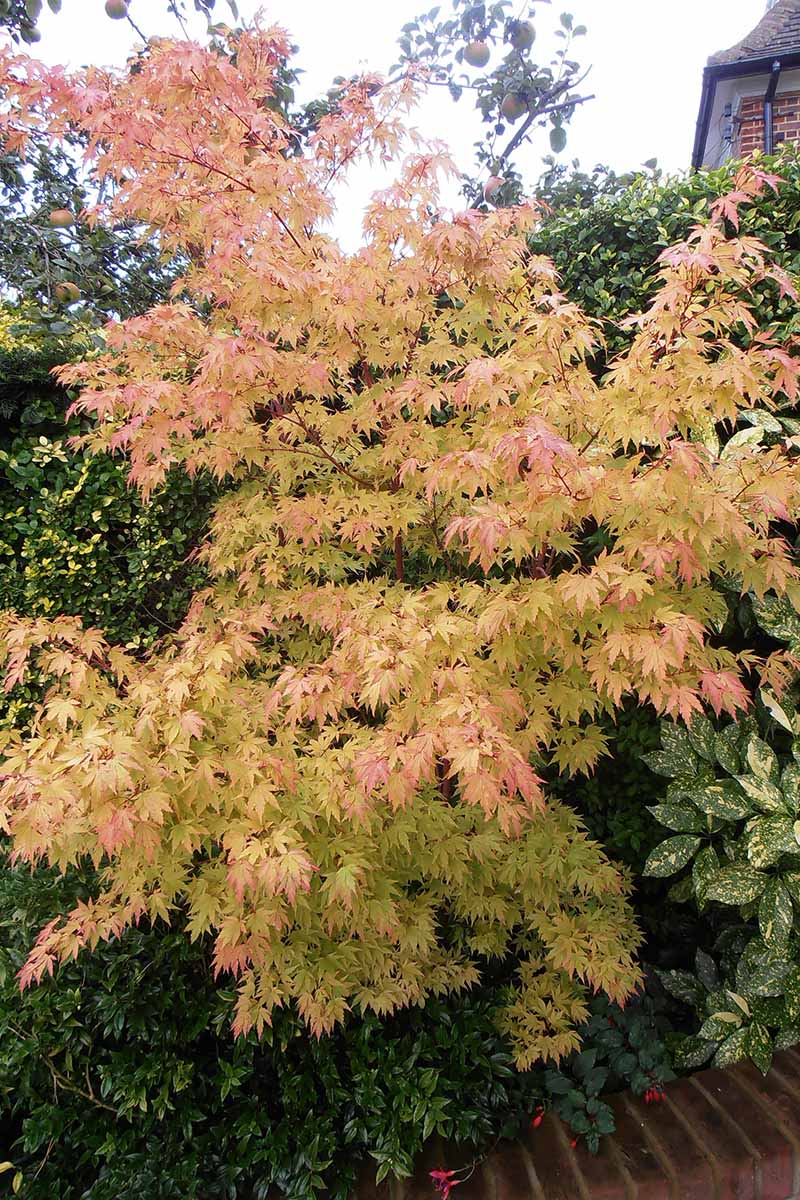
These trees can also tolerate sandy soils, leaving you with plenty of options for planting.
Soil with a pH between 5.5 and 6.5 is best for optimal growth, although this variety isn’t too picky and can tolerate values outside this range.
Irrigation and Fertilizer Needs
Once it’s established, a coral bark Japanese maple prefers moderate levels of irrigation, so water deeply whenever the top few inches of the soil dry out.
This type is also pretty drought tolerant, so don’t fret if you forget about watering on occasion once trees are established.
Japanese maples aren’t heavy feeders, so hold off on supplemental fertilization during the first year of growth. After that first year, fertilize in early spring just prior to leaf emergence.
A splendid product for the job is this all-purpose, controlled-release granular fertilizer from Osmocote, which is available in eight-pound packages at The Home Depot.
It will help to raise soil nutrient levels and feed your tree for up to six months!
Growing Tips
- Protect trees from strong winds.
- Provide well-draining soil with a pH of 5.5-6.5.
- Once established, irrigate whenever the top one to two inches of soil feel dry.
Pruning and Maintenance
Wounded maple trees bleed sap rather excessively, so it’s best to prune an Acer in late fall or winter to keep sap loss to a minimum. Sick, dead, or dying branches are an exception, and these should be pruned right away.
Detailed Japanese maple pruning instructions can be found in our guide.

Suckers may pop out of the soil near the trunk periodically, and seedlings may sprout in places where you don’t want them to. The former should be cut down as low to the ground as you can, while the latter should be pulled whenever you happen to see them.
A couple inches of mulch spread near the trunk will help with weed suppression, moisture retention, and regulating the temperature of the soil.
Not too near the trunk, though – this can suffocate and waterlog the roots. To avoid this, leave a few inches of clearance between the trunk and any adjacent mulch.
Frost damage can show up in coral bark maple trees as browned, blackened, or shriveled foliage, which isn’t an aesthetic look at all. Thankfully, the foliage usually regrows after damaged leaves fall.
To prevent frost damage in the first place, plant coverings can be draped over small, young trees, which tend to be the most vulnerable. Set yours up like a teepee with a flared base to capture rising heat.
Leaf scorch can also be an issue, especially in younger trees that are stressed by an overly warm environment or a lack of water.
This shows up as browned leaf tips, along with chlorosis or further browning between leaf veins.
Besides paying extra close attention to a coral bark’s water needs during hot and dry periods, mulching as described can help to prevent leaf scorch by conserving soil moisture.
Cultivars to Select
If A. palmatum trees were your generic fruit-flavored candy and coral barks were Skittles, then the following cultivars would be the special Wild Berry, Tropical, and Sour Skittles among them: hyper-specific kinds of an already quite particular type of sweetness.
Convoluted metaphor aside, here are some gorgeous coral bark maple cultivars to consider:
Aka Kawa Hime
Growing seven to nine feet tall and five to six feet wide at maturity, ‘Aka Kawa Hime’ is a small coral bark that packs ornamental beauty in a compact package.
Hardy down to Zone 9, this cultivar’s spring yellow-green leaves turn full-on green in summer, then take a golden-yellow shade tinged with red in fall.
A form akin to an upright vase shape ensures that despite its diminutive size, ‘Aka Kawa Hime’ still stands proudly. Trees in one- and three-gallon containers are available from Maple Ridge Nursery.
Beni-Kawa
Right out of the gate, you’ll notice that ‘Beni-Kawa’ has salmon-red bark, which is a pleasant deviation from the typical coral pink.
Upright and vase-shaped, with a height and spread of five to 15 feet at maturity, this cultivar has foliage that emerges a red-tinged light green in spring, matures to a darker green in summer, and transforms to reveal a bright golden-yellow come autumn.
It’s pretty tough to burn out on coral pink bark… but if you do, ‘Beni-Kawa’ will provide some variety that’s a few shades darker.
Maple Ridge Nursery offers ‘Beni-Kawa’ specimens in starter pots and three-gallon containers.
Eddisbury
If you want even more distance from coral pink hues, the scarlet bark of ‘Eddisbury’ is just what you’re looking for.
Bronzed-green spring leaves, bright green summer leaves, and crimson-edged golden-yellow fall foliage come standard on the ‘Eddisbury,’ along with a 10- to 15-foot height and six- to 10-foot spread when fully grown.
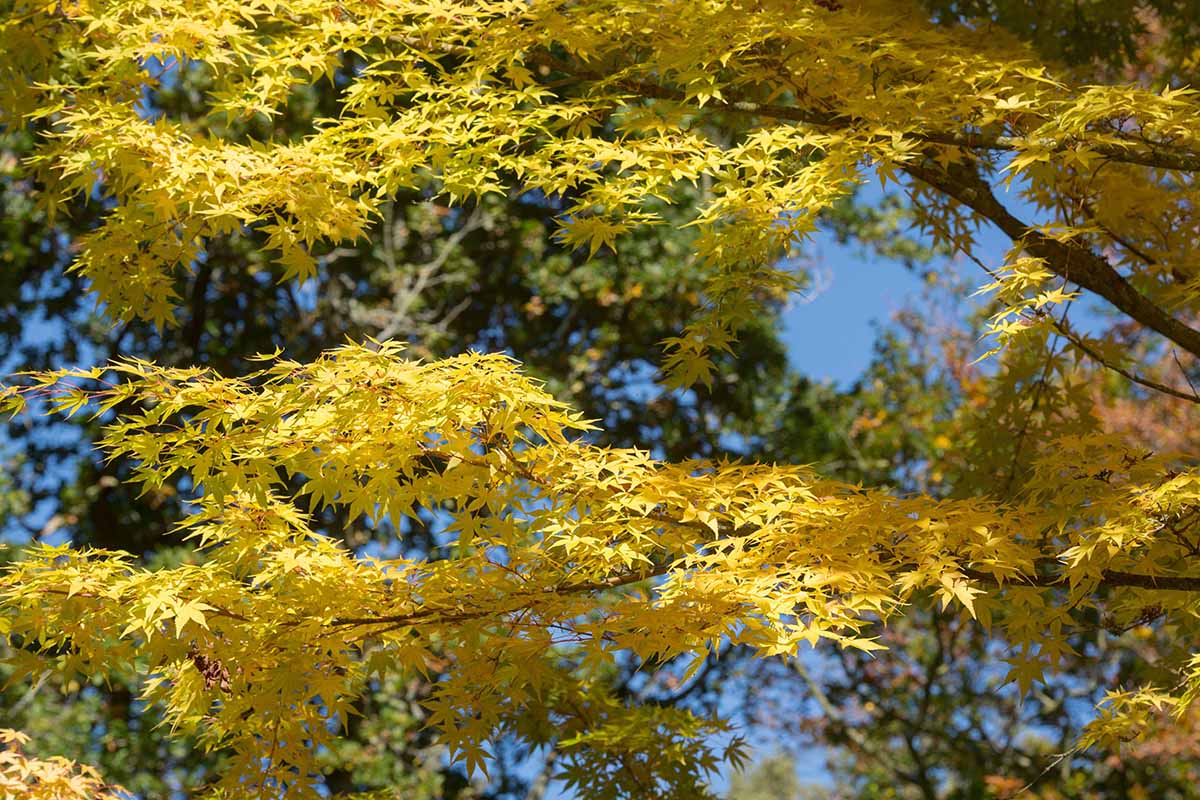
With an upright form that broadens out with maturity, this cultivar offers a red-barked alternative to the pinkness you may need a break from.
Sango-Kaku
The award-winning ‘Sango-Kaku’ reaches heights of 20 to 25 feet and spreads of 15 to 20 feet. Its spring foliage emerges in a pinkish-yellow color, matures to light green in summer, and changes to a light yellow autumnal shade before the leaves drop.
‘Sango- Kaku’ means “coral tower” in Japanese, which describes said bark and this tree’s branching habit perfectly.
This upright vase-shaped habit and iconic coral pink bark color – along with the foliage – further cement this cultivar as the undisputed poster child among coral bark maples.
To acquire one for yourself, FastGrowingTrees.com sells specimens in two- to four-foot sizes.
Winter Flame
At a height of eight to 10 feet with a spread of six to eight feet, ‘Winter Flame’ is just a bit bigger than ‘Aka Kawa Hime.’
As the only entry on this list to have a broad and rounded growing habit instead of an upright one, ‘Winter Flame’ is perfect for when you want a coral bark maple with a bit more girth in proportion to its height.
Spring, summer, and fall foliage stand out in successive color changes from lime-green to standard green, and finally in shades of yellow to orange to red before the arrival of winter.
Snag a ‘Winter Flame’ to add to your garden from Maple Ridge Nursery.
Managing Pests and Disease
It’s important to use sterilized tools, disease-free soil, and otherwise sanitary gardening practices to prevent infection and infestations from occurring.
Plus, caring for your plants properly ensures that they’ll be healthy enough to fight off any pests or diseases that happen to strike.
There are no notable herbivores to worry about, thankfully! In fact, coral barks are especially resistant to rabbit damage.
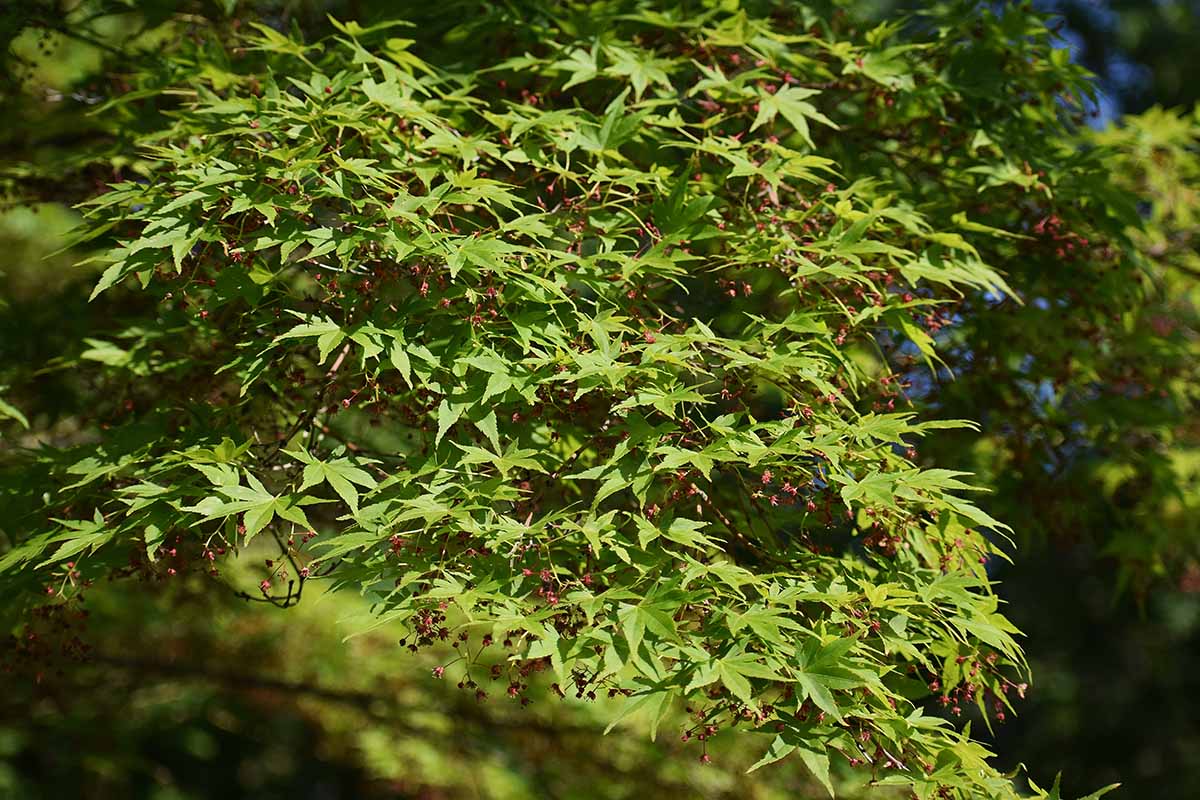
Aphids, invasive shothole borers, leafrollers, leafhoppers, and mapleworms are all creepy-crawlies that warrant keeping an eye out for. Our guide to Japanese maple pests covers these and more.
When it comes to sickness, stay on high alert for anthracnose and bacterial blight, as well as frost damage and leaf scorch.
You can learn more about Japanese maple diseases here.
Best Uses
A coral bark Japanese maple is too good-looking to serve as anything less than an alluring specimen, so place it in a spot where it will be a main focal point in the landscape.
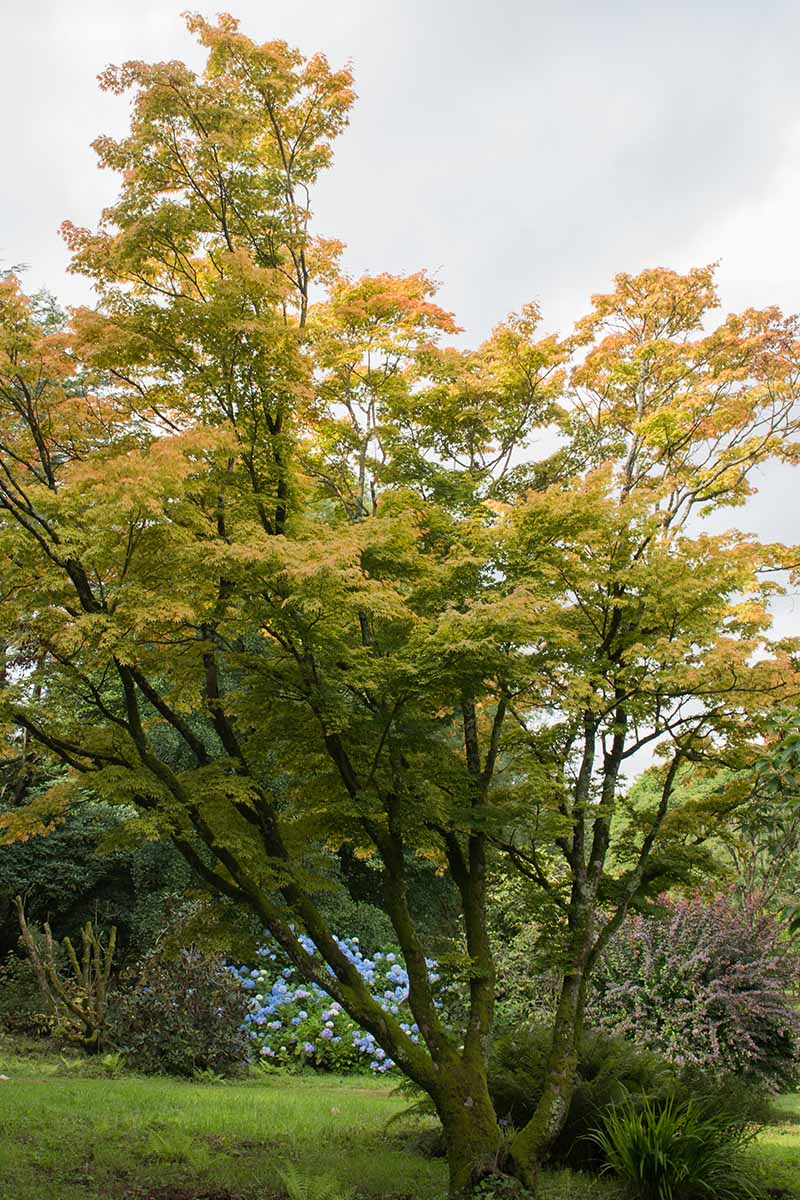
These trees provide year-round visual interest, so choose a location where yours can be viewed and enjoyed throughout each season of the year.
Quick Reference Growing Guide
| Plant Type: | Deciduous tree | Flower/Foliage Color: | Red, purple/green, yellow, orange, red (coral to red bark on new growth) |
| Native to: | China, Japan, Korea | Tolerance: | Clay soils, deer, drought, rabbits, sandy soils |
| Hardiness (USDA Zone): | 5-8 | Maintenance: | Moderate |
| Season: | Spring (fall foliage, winter bark) | Soil Type: | Fertile, sandy, silt loam |
| Exposure: | Full sun to partial shade | Soil pH: | 5.5-6.5 |
| Planting Depth: | Depth of root system (transplants) | Soil Drainage: | Well-draining |
| Spacing | 5-10 feet | Uses: | Specimen, year-round interest |
| Height: | 20-25 feet | Order: | Sapindales |
| Spread: | 15-20 feet | Family: | Sapindaceae |
| Growth Rate: | Slow | Genus: | Acer |
| Water Needs: | Moderate | Species: | Palmatum |
| Common Pests and Disease: | Aphids, invasive shothole borers, leafrollers, leafhoppers, mapleworms; anthracnose, bacterial blight | Cultivars: | Aka Kawa Hime, Beni-Kawa, Eddisbury, Sango-Kaku, Winter Flame |
A Horticultural Breakthrough
Whether it was the result of breeding or someone happened upon them in a stroke of genetic luck, coral bark Japanese maples broke new ground in the gardening world, offering year-round appeal.
Not to undersell the foliage, of course – the vast range of leaf colors on a ‘Sango Kaku’ or one of the other gorgeous varieties that are available is hard to beat.

I’ve spent a fair share of time studying Acer palmatum, and this is the coolest type of Japanese maple that I’ve come across, hands down.
I say this without hyperbole: adding a coral bark to your landscape might be one of the best gardening decisions you’ll ever make.
Any questions about, insights on, or experiences with growing this plant should go in the comments section below!
If this guide has whet your appetite for more Japanese maple know-how, satiate it with these guides next:
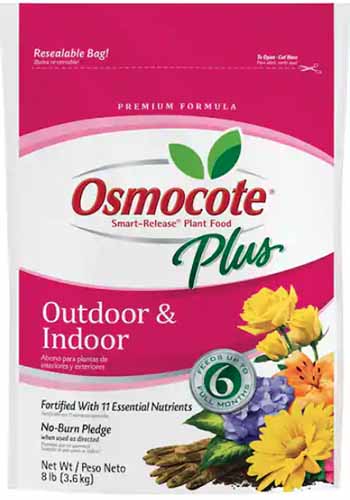
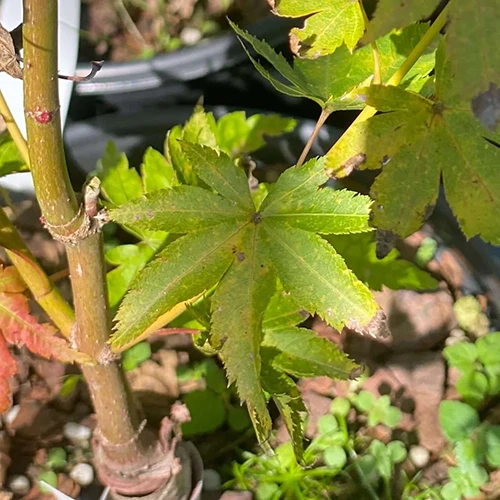
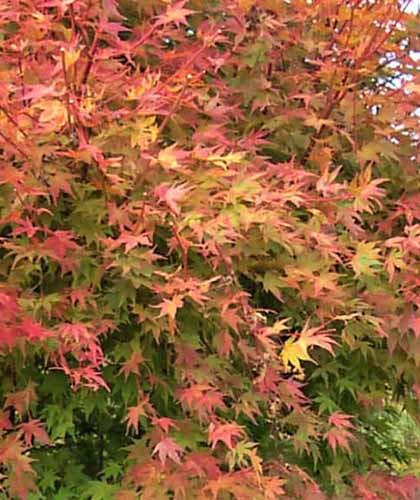
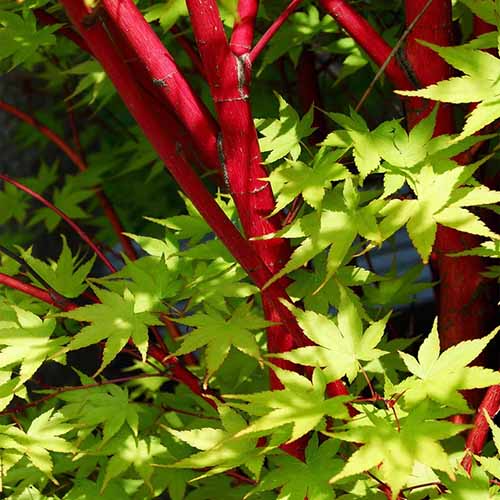
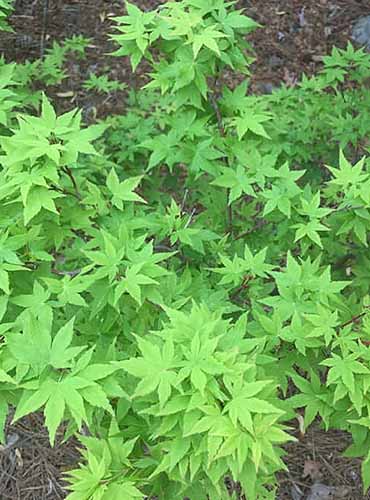
Hi Joe, great article! We are looking to plant a Coral Bark Japanese Maple in our backyard. Until I stumbled upon your article I didn’t realize there were varieties of the Coral Bark! My first question is what type of Coral Bark is pictured in the photo “Best Use” section of the article? How old would you estimate that particular tree is? My next question stems from the fact that I would like to grow a Coral Bark tree that is more “tree-like” and provides a shade canopy for human type activity. I guess that would immediately take me to… Read more »
Glad you liked the guide! And congrats on deciding to plant one of these bad boys! Japanese maples can live to be over a hundred years old. They can grow up to a foot per year, depending on size… so let’s assume that it CAN grow that fast, just to be on the safe side. Using the size of the other plants in the picture as reference, I’m guessing that this tree has an age of 20-25 years, at a minimum… but I wish I knew for sure! To answer your second question: by focusing your pruning on the lower… Read more »
My coral bark maples turn green brown bark from red. How do I get the red back?
Unfortunately, the red color faded with age, so there’s nothing that can be done. It’s a bummer, but sometimes the brightest and most beautiful flames burn out the quickest.
Good article but I have 3 Coral bark trees and I am in zone 9 and they do very well, even in full sun
How wonderful that you’re able to grow yours a bit beyond their typical recommended hardiness range!
Thank you for such a great and informative post. I just got this tree and it’s currently 5ft tall. I can’t wait to see it fully grown!
Glad you enjoyed the guide, Ophelia! And that’s great that you got yourself one! It’s well worth the wait, believe me!
Hi Joe, Really enjoyed your article. We are in zone 7a and yesterday just planted a 5 ft coral bark maple (sango kaku) in full sun ( dappled light from 4 pm on). The tag on the tree, the nursery we purchased from and almost everything I’ve read says full sun to partial shade. I worry about the leaf scorch. She had some while in her pot and there was a little more this morning. I read the tree will adjust as it gets older/more mature. I want to move her if it isn’t true. Do you have an opinion… Read more »
Hello, Kris! It warms my heart that you enjoyed the guide! Assuming you’re not under-irrigating the tree, the problem may be too much sun. Since Zone 7a is towards the southern end of the tree’s hardiness range, I think that leaning towards the more partially shaded end of the spectrum would be a wise move. Deciding on the proper plant placement for preventing heat and sun stress can be tough. So when a plant offers a range of exposure options – such as full sun to partial shade – I’ve found that using your hardiness zone to decide can be… Read more »
I purchased a Sango Kaku at a local nursery to replace a pink dogwood that was destoyed by anthranose fungus. This is a small backyard and the dogwood spot was the only available area for my new tree so I planted it in a large container to protect it from the fungus which I feared may still be in the soil. (I do not use chemicals) in my opinion it is the most graceful of Japanese Maples and has a unique beauty in the many colors of the leaves and the bark.
I agree wholeheartedly, Susan! Glad you like the tree!
I just planted a Sango Kaku this spring. It’s doing well, but has shot up 4 long shoots out the top. Should I leave them or trim them. They are LONG.
Hey, Jane! I’d definitely wait a year before pruning any part of a transplant that’s not broken, damaged, or diseased. If those shoots are still a nuisance next spring, then I’d say you can go ahead and prune.
Hi! My coral bark Japanese Maple is about five meet tall and I planted it 2 years ago with an east facing so it gets morning sun and just a little south for a short time. It has beautiful color in both it’s leaves and bark. But, this Spring it started putting out very long branches like a weeping tree. It became very heavy and full with many weeping branches,. What caused this and why? I have finally pruned it back but am concerned.
Hey, Jennifer! If the weeping growth you described was “leggy,” meaning long branches with relatively few leaves, then I’d say that it could be a cultivation issue, such as not enough sunlight, too much fertilization, over- or underwatering, crowded roots, or an improper soil.
But if it was just vigorous, fully-leafed growth that happened to droop, then I wouldn’t say it’s a huge issue. Young branches can sometimes be weighed down with their leaves, but they’ll get stronger and stiffer with age, which usually straightens them out some.
Hi Joe, I would love to have the stunning Sango-Kaku on display in my front yard! Unfortunately, I live in zone 10b so I doubt it would survive. I see Japanese Maples in the neighborhood that seem to be doing ok. Can you suggest any varieties that might do well in my zone?
Hey, Debra! On paper, heat-tolerant Japanese maple varieties are usually hardy in Zone 9 at a maximum, but if you place a tree to the north of your home, provide afternoon shade, and keep it well-watered, you may be able to create a cooler “microclimate” that’ll allow the tree to survive.
Heat-tolerant Japanese Maple varieties include ‘Mikawa,’ ‘Yatsubusa,’ ‘Summer Gold,’ ‘Ryusen Inaba,’ ‘Shidare,’ ‘Seiryu,’ ‘Shishigashira,’ ‘Tamukeyama Kiyohime,’ and ‘Emperor 1.’
Thank you for your incredibly informative article! Omg!!’ I feel like God directed me to your article as I am extremely concerned about my newly planted coral bark maple I purchased from a nursery. She stands over 12 feet tall and came in a 48 inch box so I made sure I got one that was very well established and paid a hefty price for her so I want to make sure she survives in her new home. I recently bought a new house last month and had my coral Japanese maple planted 2 weeks ago. I live in San… Read more »
Hello there, Victoria! Glad you liked the article! In general, these trees can definitely tolerate clay soils, but I wouldn’t say it’s optimal, per se. A soil texture test can tell you the ratios of sand/silt/clay that your soil contains. If your suggested new spot contains less clay than the current planting site, then it might be worth the transplant to ease your concerns, if nothing else. But if your plant exhibits symptoms of root rot such as wilting leaves, branch dieback, and discolored wood towards the base of the tree, then I’d definitely try and move the tree elsewhere,… Read more »
Thank you so much for your time in responding and your advice. It is much appreciated!